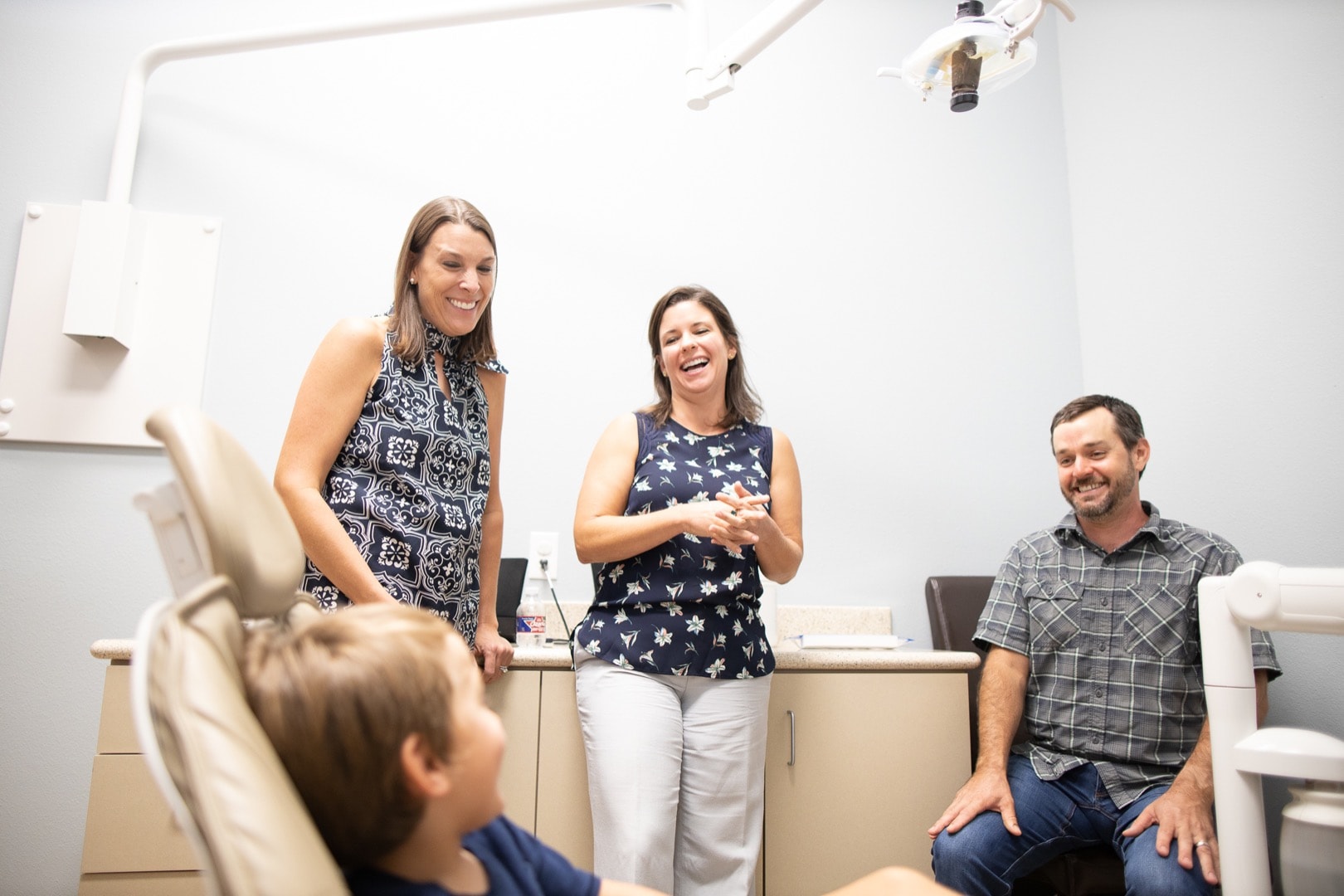Have you noticed that your child has a tongue thrust reflex, in which they unconsciously push their tongue against their front teeth? Do you recognize the signs of tongue thrust? Do you know how to fix tongue thrust?
Beavers & Broomfield Family Dentistry now offers myofunctional therapy for tongue thrust. We know the damage this bad habit can do to teeth. With the proper tools and therapy, you can end this habit and save your smile!

What Is Tongue Thrust?
What is tongue thrust? The tongue thrust reflex pushes the tongue against the front upper teeth, often unconsciously. It happens when eating, talking, sleeping, or simply sitting still.
Infant tongue thrust is common, especially as a baby learns to nurse and eat soft foods. However, that habit should disappear as the infant ages and moves to solid foods. When it doesn’t, the child (or even adult) needs therapy and treatment to stop the habit.
Children and adults can develop an open bite due to such pushing. With an open bite, the front teeth are angled outward so they don’t meet the lower teeth when the mouth is closed. Usually, braces or other orthodontic treatments are required to fix an open bite.
What Causes Tongue Thrust?
Signs of tongue thrust in adults can include speech impediments, problems swallowing, an open bite, or other teeth issues. Children may exhibit similar signs of tongue pushes.
Incorrect swallowing habits, allergies, or a tongue tie can cause tongue thrust symptoms. What is a tongue tie? It’s an extra flap of skin under the tongue that holds the tongue to the bottom part of the mouth. It makes it more difficult to move the tongue when eating and speaking.

Tongue Ties and Tongue Thrusting
A tongue tie isn’t very common but can cause problems, including tongue pushing. The thick tissue holds the tip of the tongue to the bottom of the mouth and needs to be corrected.
Babies who are born with ankyloglossia, the technical name for tongue ties, can have the problem corrected right away, though some parents wait to see how it will affect their child.
If removal is necessary, it’s usually a quick fix. A surgeon simply removes the excess skin, allowing the tip of the tongue to move more freely.
Your child may need a tongue appliance to retrain the tongue to sit and move properly. But you should start seeing improvements in your child’s ability to eat and speak fairly quickly.
Signs of Tongue Thrust in Children
The signs of tongue thrust in children and adults are similar. Here are a few things to look for to determine whether your child has a tongue-thrusting issue.
- Tongue sliding between the front teeth when speaking
- Problems pronouncing certain sounds, such as s, z, t, d, l, or n
- Ability to see the tongue between the teeth while resting
- Ability to see the tongue between teeth while swallowing
- Breathing through the mouth often
- Difficulty eating or swallowing
- Difficulty moving the lips properly
- Front teeth show an open bite
- Mouth held open at rest
How do you fix this problem? Myofunctional therapy is one way to help.

How to Stop Tongue Thrusting
Tongue thrust can be stopped in three main ways. One way is to use orthodontic appliances, such as a tongue crib, to reposition the tongue. These devices are attached to the back molars, and a basket or “crib” holds the tongue away from the teeth. The device is usually worn for 6-9 months and trains the tongue to rest against the roof of the mouth, away from the teeth.
Tongue Thrust Exercises
Beavers & Broomfield Family Dentistry works with patients to correct tongue thrust using special exercises. These tasks help train the tongue and surrounding muscles. They can be performed on patients with or without a tongue crib.
These exercises correct problems such as reverse swallowing, something small children may develop. Reverse swallowing can cause tongue thrust, eventually leading to eating and digestive issues.
Other exercises are designed to teach the tongue where to rest in the mouth. The tongue is made to rest against the palate and away from the teeth, but tongue thrust patients often have their tongues resting against their teeth. We have exercises that can move the tongue back to where it belongs.
Tongue Thrust Therapy
Tongue-placement therapy may not be enough to correct your child’s tongue-thrust issues. Your child may still have problems speaking certain sounds. Myofunctional speech therapy can correct this problem.
Myofunctional tongue thrust therapy can help retrain the tongue to form sounds correctly by hitting the proper parts of the mouth. We use this therapy to teach your tongue and facial muscles when to hit the roof of the mouth or the back of the teeth to make certain sounds.
Not every patient will need speech therapy, while some may require even more intense therapy from a speech-language pathologist or a speech therapist. The orofacial myofunctional therapy exercises will often be enough to correct all tongue-thrusting problems, including eating and speech. We will work with you and your child to determine if speech therapy is best for you.
Therapy for Tongue Thrust in Fayetteville, AR
Tongue thrusting is a habit that can damage oral and overall health. If not treated quickly, it can cause speech and eating problems, as well as issues with self-confidence, self-esteem, and nutrition.
If you suspect your child has tongue-thrusting issues in Fayetteville, AR, schedule an appointment with Beavers & Broomfield Family Dentistry. We are here to help!





